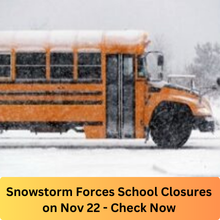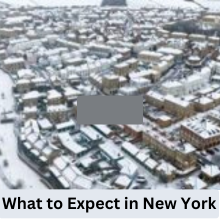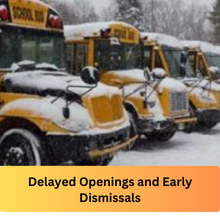Winter weather is making its presence known across parts of the United States, particularly in the northern and eastern regions, leading to disruptions in school schedules. On Friday, November 22, 2024, several school districts in Kentucky, New Jersey, and New York have announced closures, delayed openings, and schedule alterations due to snow and icy conditions. This article provides a detailed look at the school closings, the impact of winter storms, and what families can expect during these disruptions.
School Closures in Kentucky
Several school districts in Kentucky have announced closures due to the winter storm moving through the region. The snow has caused unsafe travel conditions, forcing schools to close for the day.
- Bell County Schools: Closed, NTI (Non-Traditional Instruction) Day #2
- Floyd County Schools: Closed, NTI Day
- Harlan County Schools: Closed, NTI Day #1
- Jackson Independent Schools: Closed, NTI Day
- Knox County Schools: Closed, NTI Day
- Leslie County Schools: Closed
- Letcher County Schools: Closed, NTI Day
- Middlesboro Independent Schools: Closed, NTI Day #2
- Morgan County Schools: Closed
- Pineville Independent Schools: Closed, NTI Day #3
- Red Bird Christian School: 2-hour delay
- Small Wonders Daycare: Closed
- SE KY Community and Technical College: Closed, remote operation
- Wolfe County Schools: Closed, NTI Day #1
These closures are part of a larger pattern of disruptions as the region faces heavy snow accumulation and hazardous road conditions.
School Closures in New Jersey
Winter weather has also impacted New Jersey, especially in its northern counties, where up to 6 inches of snow is expected. The National Weather Service has issued winter weather advisories for areas including Morris, Passaic, Sussex, and Warren counties.
- Northern New Jersey: Schools in Morris, Passaic, Sussex, and Warren counties are likely to be affected by the snowstorm, with many districts announcing early closures or full cancellations for the day.
The snowstorm has created significant disruptions in both local transportation and school operations. In some districts, schools have switched to remote learning to maintain instructional time.
Winter Storm Alerts in New York
Upstate New York is bracing for one of the season’s first major snowstorms. The National Weather Service has issued winter storm warnings across multiple counties, including Tompkins, Madison, and Sullivan counties, predicting up to a foot of snow in certain areas.
- Winter Storm Warnings: These warnings are in effect through Friday afternoon and cover a large swath of New York, including the Catskills and parts of the Southern Tier. Snow accumulation is expected to be heavy, with some areas seeing up to 16 inches of snow.
The snowstorm is expected to be wet and heavy, which could lead to power outages, dangerous travel conditions, and more school closures.
What to Expect in New York
As the storm moves east, snow is expected to accumulate quickly, especially in higher elevations. The forecast calls for:
- 12 to 16 inches of snow in the highest regions, including parts of the Catskills.
- 6 to 12 inches of snow expected at high elevations above 1,500 feet.
- 1 to 4 inches in the valleys.
This significant snowfall will affect travel and school operations, with many school districts opting for closures or delays due to hazardous travel conditions.
Winter Storm Warning: What Does It Mean?
A winter storm warning is the highest level of alert issued by the National Weather Service. It indicates that severe winter weather is imminent or occurring and that conditions will likely cause dangerous travel, power outages, and damage to infrastructure.
- What to Expect: During a winter storm warning, snow, sleet, or freezing rain can cause significant disruptions. Travelers should avoid unnecessary trips, and individuals should prepare for potential power outages.
- Safety Measures: Residents are advised to stay indoors, keep emergency supplies on hand, and ensure that vehicles are winterized for safe operation.
Impact on Schools and Education
School districts across the affected regions are taking different approaches to deal with the disruptions caused by the storm. Some schools are closed for the day, while others are utilizing remote learning options. Many Kentucky schools have declared Non-Traditional Instruction (NTI) days, where students continue their education at home via online platforms.
- Remote Learning: Schools that switch to NTI days are providing students with assignments and lessons that can be completed at home, ensuring that the educational process continues even during snow days.
- Emergency Days: If schools do not have enough NTI days built into their schedule, they may need to extend the school year or adjust the calendar to make up for lost instructional time.
The Role of Local Governments in School Closures
Local governments play a significant role in determining when schools should close due to weather conditions. School superintendents and emergency management teams assess the situation and collaborate to make decisions that prioritize the safety of students and staff.
- Factors in Decision-Making: Road conditions, the severity of the storm, and anticipated snow accumulation all influence whether schools will remain open or close.
- Communication with Families: Districts typically use multiple platforms—emails, social media, and phone calls—to notify families about closures or schedule changes.
Delayed Openings and Early Dismissals
When snowfall is less severe or expected later in the day, some districts opt for delayed openings. This means that schools start a few hours later than usual to allow for the weather to improve.
- Challenges with Delayed Openings: Although delayed openings are a way to keep schools open while ensuring safety, they can present challenges for families who need to adjust schedules and make arrangements for childcare.
- Early Dismissals: In some cases, if the weather worsens throughout the day, schools may opt for early dismissals to get students home before conditions become dangerous.
Also read: Nugget Is Dead? Steph Faces Tough Choices in Christmas Drama
Travel Disruptions and Safety Concerns
Travel disruptions are a major concern when winter storms hit, particularly for commuters and school buses.
- Road Conditions: The snow and ice make roads slippery, increasing the risk of accidents and delays. Snowplows and salt trucks work hard to keep roads clear, but some areas may remain treacherous for hours after the storm passes.
- Traffic Warnings: Local authorities issue travel advisories to keep residents informed about road conditions. In some regions, travel bans are put in place for commercial vehicles or drivers in general.
Winter Weather Precautions
It’s essential for families to take necessary precautions before and during winter storms.
- Home Safety: Ensure that homes are properly insulated and winterized to avoid heating issues during power outages.
- Car Safety: Keep your vehicle stocked with essentials like a blanket, flashlight, food, and water in case of emergencies.
Snowfall in Upstate New York
In Upstate New York, the storm is expected to hit hardest in the Southern Tier and the Catskills, with snow accumulation expected to exceed 16 inches in higher elevations. Areas along the I-90 corridor may see rain instead of snow due to warmer temperatures.
National Weather Service Alerts
Understanding winter weather alerts is critical to staying safe during snowstorms. The National Weather Service issues several types of warnings, including winter storm warnings, winter weather advisories, and blizzard warnings, each indicating the severity of the weather conditions.
Preparing for Snow and Winter Weather
Before a snowstorm, it’s important to prepare for the potential disruption. This includes having emergency supplies on hand, making arrangements for childcare if schools are closed, and ensuring that your car is ready for winter driving.
Also read: Retirement Home Crime Solved? Discover ‘A Man on the Inside’ Mystery
Conclusion
The winter storm on Friday, November 22, 2024, has caused significant disruptions across parts of Kentucky, New Jersey, and New York. As snow and ice affect road conditions and school operations, it’s crucial for families to stay informed and prepared. Whether schools are closed, operating remotely, or delayed, ensuring the safety of students and staff is the top priority during these winter weather events.
FAQs
What are NTI Days?
Non-Traditional Instruction (NTI) days are days when students continue learning remotely due to inclement weather or other disruptions.
How Can Parents Prepare for School Closures?
Parents should stay informed through school notifications and prepare backup childcare plans in case of closures or delays.
What Should Students Do During School Closures?
Students should complete assignments or engage in remote learning activities if their school is using NTI days.
Why Do Some Schools Stay Open While Others Close?
School closure decisions depend on factors like snow accumulation, road conditions, and local safety assessments.
How Do School Districts Notify Families of Closures?
School districts typically use email, social media, and automated phone calls to notify families about closures or schedule changes.


